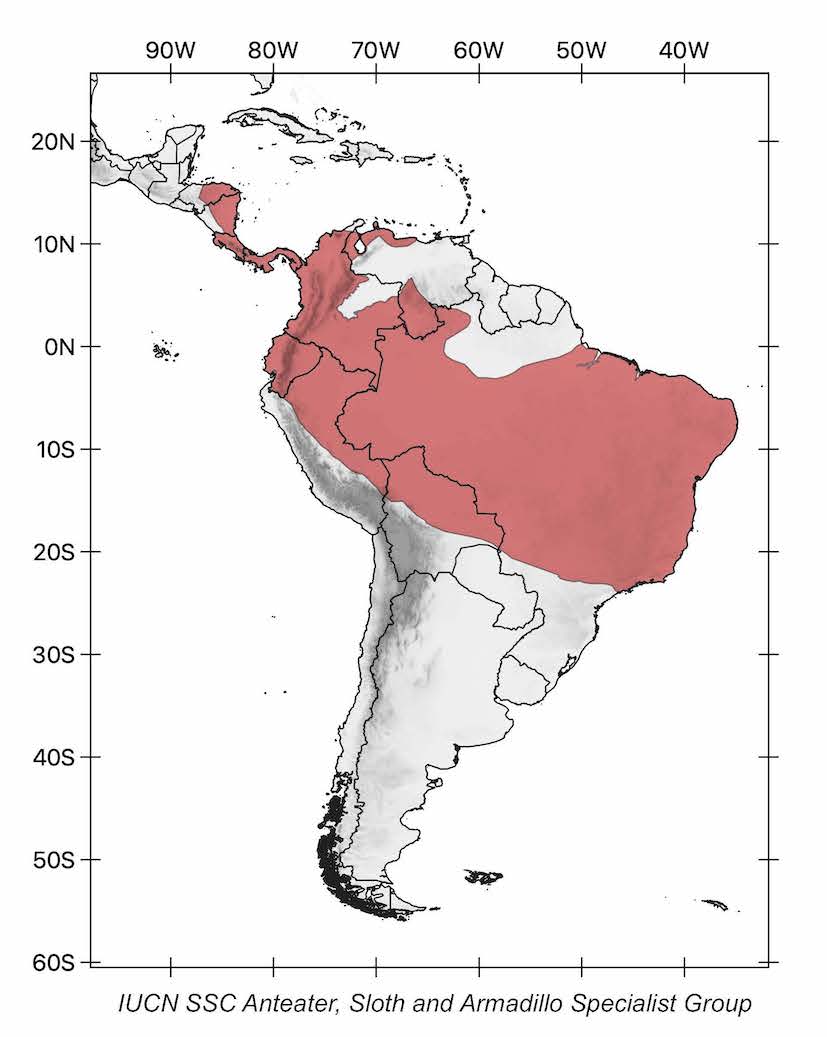Brown-throated three-toed sloth
(Bradypus variegatus)
other common names
Brown-throated sloth
Taxonomy
Order: Pilosa
Family: Bradypodidae


description
This sloth has a head-body length of 52–54 cm and a small, vestigial tail of around 5 cm. It weighs around 3.7–6 kg. The forelimbs are long (37–45 cm), and the hindlimbs relatively short (32–37 cm). Its body is covered with long, coarse, gray hair, but they often look greenish due to the algae that grow on their hair. There is a dark stripe over a lighter colored and browner face, giving the appearance of a mask. Males have a dorsal speculum of shorter cream to orange-colored hair, with a dark stripe running vertically down the center of it.

range
This sloth species ranges from Honduras in the north, through southern Central America. In South America, it occurs from Colombia to western and southern Venezuela, as well as south into Ecuador, eastern Peru and Bolivia, and most of Brazil.

HaBITAT and ECOLOGy
Bradypus variegatus has been recorded from a number of forest types including seasonal mesic tropical forest, semi-deciduous forest (inland Atlantic Forest), cloud forest, and lowland tropical forest. It inhabits cacao (Theobroma cacao) plantations in Costa Rica. Indeed, regenerating forests, such as those disturbed by shade cacao plantations, might provide positive population growth for this species.
Brown-throated three-toed sloths are usually more active during the day than at night. Home range size is between 0.1 and 19 hectares, and an individual moves on average only 40 m per day. Population densities have been estimated at 0.6 to 8.5 animals per hectare. The species has the ability to withstand habitat changes. Individuals that lose their habitats partially or totally are able to use the resources offered by vegetation fragments in urban areas, both in preserved or restored areas (parks, reserves) and those used for urban afforestation. This fact refers mainly to the Atlantic Forest region of Brazil, as it has become a very critical environment for the survival of B. variegatus due to the high degree of anthropization related to the growth of numerous cities along the coast of Brazil. The species is also commonly found in public squares, where densities can reach 12.5 animals per hectare. Although it uses many different tree species, a sloth usually has a few “modal” trees within its home range on which it spends most of the time resting and foraging.

reproduction
The brown-throated three-toed sloth produces one litter of a single offspring at intervals of at least 19 months. The mating period varies depending on the year and geographical region, but occurs mainly in spring (i.e., from July to November in South America and from February to May in Central America). Gestation is about 6 months. The offspring completely depend on their mother for at least 100 days, during which they cling to its belly.

diet
This is a strict folivore that eats leaves in canopies of trees. It can feed on more than 50 plant species and prefers young leaves. Its digestion is extremely slow, and it climbs down to the ground to defecate only once a week.

curious facts
Sloths, algae, and certain moths have a mutualistic relationship. The hair of sloths have deep grooves or cracks that are colonized by algae. Moths living in the sloth’s fur provide nutrients that the algae need for growth. When the sloths climb down to defecate, they transport the moths to the sloth dung, where the insects lay their eggs. The moth larvae then feed on the dung. When the sloth climbs down again, adult moths get from the dung into the fur, closing the cycle. The algae provide the sloths protection from predators via camouflage by giving their fur a greenish appearance, but they can also be used as a food source.

threats
Furthermore, they are hunted by local indigenous communities. Wild-caught individuals, especially offspring, are sold as pets to tourists in Colombia, Bolivia, and Honduras. This illegal trade is increasing and represents a cause of concern due to its impact on the wild populations. The species is handled by tourists in Central and South America, including the Peruvian and Brazilian Amazon, as an attraction for the “selfie” market. Mortality on roads also occurs.

Population trend
Decreasing.

conservation status
Bradypus variegatus is listed as Least Concern in view of its wide distribution including a large part of the Amazon forest, presumed large population, and its occurrence in a number of protected areas. Although there are threats, such as habitat loss due to deforestation, wildfires, illegal trade, and the use of wild individuals for selfie tourism, they are not thought to be causing significant declines in the global population. They may, however, do so at the local level and warrant listing of the species in a threatened category in regional Red Lists. The species is included in CITES Appendix II.